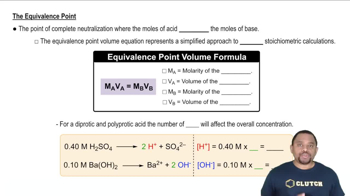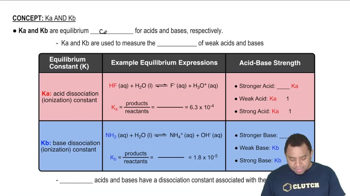Here are the essential concepts you must grasp in order to answer the question correctly.
Molar Mass Calculation
Molar mass is the mass of one mole of a substance, typically expressed in grams per mole (g/mol). To calculate the molar mass of ascorbic acid in this scenario, you can use the mass of the sample and the number of moles of KOH used at the equivalence point. The relationship between moles, mass, and molar mass is given by the formula: Molar Mass = Mass / Moles.
Recommended video:
Molar Mass Calculation Example
Titration and Equivalence Point
Titration is a quantitative analytical method used to determine the concentration of a solute in a solution. The equivalence point is reached when the amount of titrant added is stoichiometrically equivalent to the amount of analyte in the solution. In this case, the volume of KOH at the equivalence point allows for the calculation of moles of ascorbic acid, which is essential for determining its molar mass.
Recommended video:
Equivalence Point in Titration
Dissociation Constant (Ka)
The dissociation constant (Ka) is a measure of the strength of an acid in solution, indicating how well it donates protons (H+) to the solution. For weak acids like ascorbic acid, Ka can be calculated using the concentrations of the products and reactants at equilibrium. In this case, the pH at a specific volume of KOH added can be used to find the concentration of H+ ions, which is necessary for calculating Ka.
Recommended video:
Characteristics of Ka and Kb




